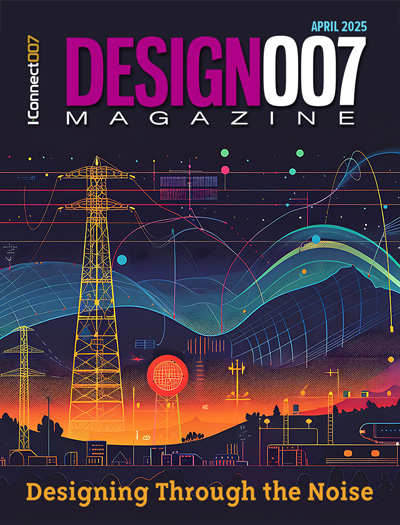-

- News
- Books
Featured Books
- design007 Magazine
Latest Issues
Current Issue
All About That Route
Most designers favor manual routing, but today's interactive autorouters may be changing designers' minds by allowing users more direct control. In this issue, our expert contributors discuss a variety of manual and autorouting strategies.

Creating the Ideal Data Package
Why is it so difficult to create the ideal data package? Many of these simple errors can be alleviated by paying attention to detail—and knowing what issues to look out for. So, this month, our experts weigh in on the best practices for creating the ideal design data package for your design.

Designing Through the Noise
Our experts discuss the constantly evolving world of RF design, including the many tradeoffs, material considerations, and design tips and techniques that designers and design engineers need to know to succeed in this high-frequency realm.
- Articles
- Columns
- Links
- Media kit
||| MENU - design007 Magazine
Nano Dimension’s 3D Printing: Prototypes at the Push of a Button?
January 26, 2018 | Barry Matties, Publisher, I-Connect007Estimated reading time: 5 minutes
SICK AG is a global manufacturer of sensors and sensor solutions for industrial applications, with headquarters located in Waldkirch, Germany. After a demo of Nano Dimension’s new 3D printing machine at productronica, Barry Matties met with SICK’s Danny Wernet to discuss its pros and cons and get his overall impression of the technology. Are 3D prototypes really as simple as feeding in a Gerber file and pushing a button?
Barry Matties: Danny, can you share a little bit about your company and what you do?
Danny Wernet: We provide sensors and application solutions from factory automation to logistics automation and process automation, mainly for B2B. In this context we are one of the leading sensor manufacturers and a technology and market leader. Worldwide, we have about 8,000 employees, generating sales of about €1.4 billion.
Matties: What's your position?
Wernet: I am a business analyst in the electronics production in Waldkirch, which is in Southwest Germany.
Matties: We’re standing here looking at a Nano Dimension system for rapid prototypes. How does SICK take care of its customers’ prototype needs?
Wernet: We buy PCBs in the traditional way. If we need some PCBs for prototyping, we buy them in the market. SICK doesn’t produce PCBs.
Matties: For a few pieces, right? For three to five pieces.
Wernet: Yes, a few pieces. We produce relatively complex boards what results in a delivery time of between one and three weeks for these PCBs. This time is lost in order to reduce throughput time for assembly. Rapid prototyping of PCB could be a chance to offer R&D assemblies within a period of a few days. This might reduce time to market and provide competitive advantage. That's the issue to do it on our own.
Nano Dimension’s system is capable of printing one or two samples a day. It seems that batches with higher quantities cannot be produced economically yet.
Matties: So this is clearly just a single board.
Wernet: It is, obviously the system delivers samples in the short run which can be used to verify circuit design. To do the industrialization in production, we need some more…
Matties: Horsepower.
Wernet: Of course. In case R&D needs one or two prototypes to do some electrical measurement, it might be a solution. Coming to productronica, one of our goals was to get more information in order to speak internally about the next steps.
Matties: After the demonstration here, what's your impression? What did you walk away with?
Wernet: The technology is very interesting and will potentially cover a relevant part of the market share of PCB manufacturing in the future. As an internal electronics manufacturer for SICK’s PCBAs, we offer the complete value-added chain from accompanying the earliest steps of R&D to series production to our internal customers. Therefore, the rapid prototyping of PCBs offers us possibilities that we did not have in the past.
Matties: What were the drawbacks that you saw in the demonstration? Things that may concern you about this?
Wernet: The system is new in the market and there is little experience. Design rules have to be developed first, before the printed PCBs can be used as a sample with similar characteristics as later on in series production. There is always a risk being the first to use a new technology.
The system’s performance can be seen as a drawback, too. So, one board, depending on size and thickness, is printed up in approximately 5-15 hours; this needs to be reduced in the future.
Matties: What were the greatest benefits that you saw?
Wernet: As already mentioned, first of all, the reduction of procurement lead time for the PCB is the greatest benefit. From a production point of view, the technology itself is an advantage. I was wondering about how to do the programming, how to do the handling, the maintenance, and the service. As far as I can evaluate these issues, all of them seem to be manageable and are less extensive as I expected.
Matties: I agree, and I think the speed barrier is only a matter of time, right?
Wernet: Sure. The speed of the system and output will increase. Another issue to mention is the soldering temperature. The printed materials cannot withstand the soldering process with standard lead-free alloys with a melting point of about 220°. There are lead-free alternatives for low-temperature soldering, of course. However, it is recommended to solder these alloys using vapor phase technology which comes along with another investment and the need to increase production knowledge.
Matties: You'd have to change the process to make this work in your facility.
Wernet: At the moment, we do not have experience in vapor phase soldering. Investment in a laboratory vapor phase system is relatively low, but the process needs to be developed.
Matties: Now in terms that the way that the process works, it looks like you upload your Gerber, and you press a print button. And hours later, you have a completed prototype.
Wernet: That’s the ways Nano Dimension’s technicians presented the process. Everybody has Gerber; it's a kind of the industry standard. The operator has to define the thickness of each layer only. I do not think that it's an issue.
Matties: I know it's a process. The one good question you had during their presentation was the shelf life, or the life of the material, and it seems like the answer was a bit surprising to you.
Wernet: I'm not yet an expert in 3D printing, but we do a lot of dispensing, and there we are not familiar with a pot life of six months.
Matties: Right, you were expecting six hours.
Wernet: Or something like this. It's not an issue. We do dispensing, and there we have to do massive cleaning of the heads. As I said, I'm not an expert in inkjet and 3D, but I was positively surprised about the pot life and the two hours per week of maintenance. That was a really good issue that was not expected.
Matties: Is there anything that we haven't discussed that you would like to talk about?
Wernet: Of course, for curing, Nano Dimension uses infrared for one material and UV for the other. In order to increase process reliability, I would prefer one curing system. Another issue for me is that everything—process, machinery and auxiliary materials—is coming only from Nano Dimension; this might be a risk, and it has to be considered before the investment is made.
Matties: Nano Dimension mentioned the distributors, but it sounds like distributors are their market, right? It's all proprietary.
Wernet: Someone has to be first.
Matties: Well, congratulations on being here, and thank you for sharing your thoughts.
Wernet: Thank you.
Suggested Reading
Printing PCBs...In Your Office!
The days of producing a PCB prototype with a 3D printer may not be as distant as you think. Barry Matties spoke with Simon Fried of Nano Dimension about how 3D printing is becoming a reality, and how this disruptive technology will change the way designers produce rapid prototypes.
Suggested Items
Driving Innovation: Direct Imaging vs. Conventional Exposure
07/01/2025 | Simon Khesin -- Column: Driving InnovationMy first camera used Kodak film. I even experimented with developing photos in the bathroom, though I usually dropped the film off at a Kodak center and received the prints two weeks later, only to discover that some images were out of focus or poorly framed. Today, every smartphone contains a high-quality camera capable of producing stunning images instantly.
Hands-On Demos Now Available for Apollo Seiko’s EF and AF Selective Soldering Lines
06/30/2025 | Apollo SeikoApollo Seiko, a leading innovator in soldering technology, is excited to spotlight its expanded lineup of EF and AF Series Selective Soldering Systems, now available for live demonstrations in its newly dedicated demo room.
Indium Corporation Expert to Present on Automotive and Industrial Solder Bonding Solutions at Global Electronics Association Workshop
06/26/2025 | IndiumIndium Corporation Principal Engineer, Advanced Materials, Andy Mackie, Ph.D., MSc, will deliver a technical presentation on innovative solder bonding solutions for automotive and industrial applications at the Global Electronics A
Fresh PCB Concepts: Assembly Challenges with Micro Components and Standard Solder Mask Practices
06/26/2025 | Team NCAB -- Column: Fresh PCB ConceptsMicro components have redefined what is possible in PCB design. With package sizes like 01005 and 0201 becoming more common in high-density layouts, designers are now expected to pack more performance into smaller spaces than ever before. While these advancements support miniaturization and functionality, they introduce new assembly challenges, particularly with traditional solder mask and legend application processes.
Knocking Down the Bone Pile: Tin Whisker Mitigation in Aerospace Applications, Part 3
06/25/2025 | Nash Bell -- Column: Knocking Down the Bone PileTin whiskers are slender, hair-like metallic growths that can develop on the surface of tin-plated electronic components. Typically measuring a few micrometers in diameter and growing several millimeters in length, they form through an electrochemical process influenced by environmental factors such as temperature variations, mechanical or compressive stress, and the aging of solder alloys.


